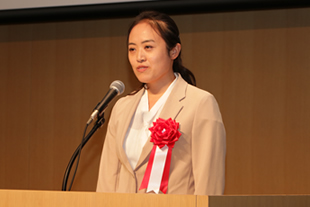 The 21st Asia Pacific Research Prize winner: Dr. Le Wang
The 21st Asia Pacific Research Prize winner: Dr. Le Wang
Title of Dissertation: “A Media Historical Study of Pacification and Propaganda Activities in Rural Areas of Manchukuo”

- Dr. Le Wang
-
- Career -
Le Wang is an assistant professor in Graduate School of Information Sciences at Tohoku University. Trained interdisciplinarily in media history and historical sociology, she is broadly interested in the relationship between war and culture. She received her Joint B.A in Japanese and Economics from Heilongjiang University(2011), M.A.in Interdisciplinary Information Studies from University of Tokyo(2015), and PhD in Interdisciplinary Information Studies from University of Tokyo(2021).Her prior research and teaching positions include JSPS Research Fellow(DC2),Research Fellow of Waseda Institute of Political Economy, and Research Fellow of Interfaculty Initiative in Information Studies at The University of Tokyo, Lecturer of Department of Global Media Studies at Komazawa University.
- Summary -
Propaganda activities in rural areas of Manchukuo called Senbu(the meaning of pacification)was emphasized officially by Japanese authorities in Manchukuo. This media-historical research focuses on the multifaceted interpretations of media’s utilization in Senbu to clarify the actual situation of governance policies in rural areas of Manchukuo based on the primary historical materials.Chapter 1 elucidates the discursive formation of Senbu among the Japanese authorities accompanying the implementation of propaganda activities. This part is followed by a discussion on the multi-target feature of propaganda activities and the uniqueness of media. To illuminate the trajectory of Senbu, chapter 2 traces the historical development of propaganda activities in Manchuria as well as the improvement of educational and technical infrastructures of Senbu. Chapter 3 reveals several specific methods of Senbu such as the production of hygiene films, various outdoor screening practices cooperated with other medical activities or lectures that were expected to enhance the efficiency of Senbu. Chapter 4 throws lights on how Senbu took advantages of religious ceremonies and their regular markets in order to gather audience groups in scarcely populated areas of Manchukuo. The final chapter summarizes how Senbu has transformed and been transformed by local society. This thesis attempts to fill the blank of historical studies about Manchukuo’s propaganda activities in rural areas while provide a brand-new analytical perspective for unifying the multiple media in the field of media studies.






